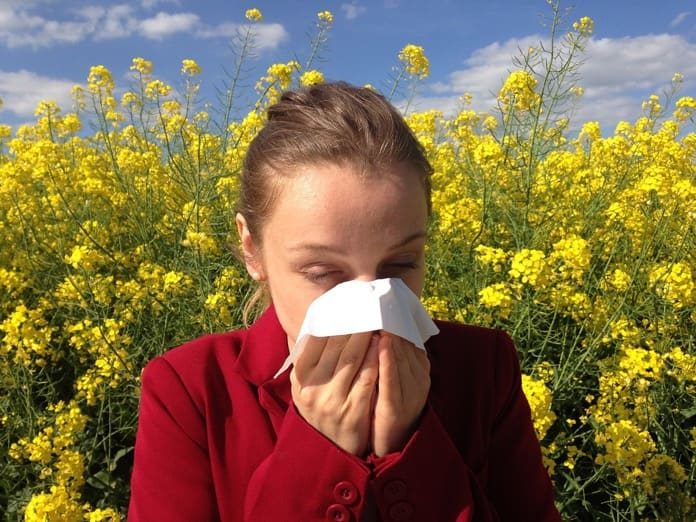With the arrival of spring, many people experience spring allergies. Here, we discuss the top four ways to treat spring allergies.
With the arrival of spring, many people experience spring allergies, also called hay fever or allergic rhinitis. Spring allergies often occur when the body reacts to certain tree pollen. Other common allergens include dust, animal dander, or air pollution.
At first, the immune system becomes sensitive to these substances. On subsequent exposure, an allergic reaction occurs and the immune system releases a chemical called histamine. Histamine acts on the eyes, nose, throat, lungs, skin, or the digestive tract, causing allergic symptoms, which can be treated.
Common symptoms of spring allergies include:
- Sneezing
- Runny, stuffy, or itchy nose
- Reduced smell sensation
- Red, itchy, watery eyes
- Headache and fatigue
- Fullness in nose and ears
- Facial pain
- Dark circles under the eyes
- Nasal secretions dripping into the back of the throat(post-nasal drip)
- Cough or sore throat
- Snoring
1. Reduce exposure to pollen
The best way to deal with allergies is to avoid the allergen. However, it is not always possible to avoid environmental triggers, but minimizing it can help prevent spring allergies.
Individuals can reduce exposure to pollen by:
- Staying indoors on dry, windy days, especially during midday and afternoon. Try to spend days outside after a good rainfall when the air has been cleared of pollen.
- Maintain hygiene by keeping doors and windows closed to reduce dust and the amount of pollen getting into the home.
- Avoid lawn mowing, weed pulling, and other gardening activities.
- Take a shower and be sure to wash your face and eyes properly after outdoor activities. It is also important to change clothes after returning home.
- Avoid drying clothes outside, especially during early morning and early evening when pollen counts are high. Pollen can stick to towels and sheets.
- Wear a pollen mask while spending time outdoors.
- Use high-efficiency particulate air (HEPA) filters in your home air heater and air conditioner, and with the vacuum cleaner. These filters trap pollen and dust.
- Regularly maintain your air heater and air conditioner.
2. Home remedies to treat spring allergies
1. Nasal irrigation: Rinsing your nose and sinuses with clean, sterile saline flushes out the allergens and relieves nasal congestion. Special squeeze bottles are available at pharmacy stores for nasal rinsing.
2. Vaporisers or humidifiers: Vaporisers or humidifiers increase moisture (humidity) in the air. Use them in the house during dry days. A steam vaporiser releases steam into the air by boiling the water. It is important to use distilled water and carefully follow the instructions for a clean, germ-free mist. Some devices may require regular change of water.
3. Over-the-counter medicines
1. Antihistamines: These drugs reduce the amount of histamine released, thus decreasing the symptoms. Examples include cetrizine, loratadine, and fexofenadine. They can be taken even before the exposure to an allergen. These drugs reduce sneezing, watering from eyes and nose. But some of them can be sedating, read the label before using them. Seek the opinion of your health care provider for their suitable usage.
2. Nasal Decongestants: Oral drugs like pseudoephedrine and nasal sprays like oxymetazoline can reduce nasal stuffiness. However, using nasal sprays for a longer period can actually worsen the symptoms and cause rebound congestion. Restrict their use for a few days at a stretch.
3. Steroid nasal sprays: If the anti-histamines and decongestants are not helpful, steroid nasal sprays, like triamcinolone or fluticasone, can be tried. Starting these nasal sprays several weeks before the peak season can help to treat spring allergies and avoid symptoms.
4. Analgesics: For pain relief, analgesics like ibuprofen or acetaminophen can be used.
5. Allergy shots: Allergy shots (immunotherapy) can be a suitable option for some individuals. This treatment involves injecting small amounts of allergen into your body to reduce the immune reaction. Some treatments can be given as tablets under the tongue. However, the specific allergen must be known. It is important to consult your doctor before considering this option.
4. See your doctor
When the symptoms of spring allergies bother you and impact your daily work activities, take the help of your health care provider and discuss what treatments will work best for you. Combining several remedies can help abate spring allergies.
Written by Dr. Radhika Baitari, MS
References:
- Hay Fever and Other Seasonal Allergies [Internet]. HealthLink BC. 2019 [cited 16 April 2019]. Available from: https://www.healthlinkbc.ca/health-topics/tv6577
- Taking Control – Asthma Canada [Internet]. Asthma Canada. 2019 [cited 16 April 2019].Available from: https://asthma.ca/allergies/taking-control/
- Seasonal allergies: Nip them in the bud [Internet]. Mayo Clinic. 2019 [cited 16 April 2019]. Available from: https://www.mayoclinic.org/diseases-conditions/hay-fever/in-depth/seasonal-allergies/art-20048343



